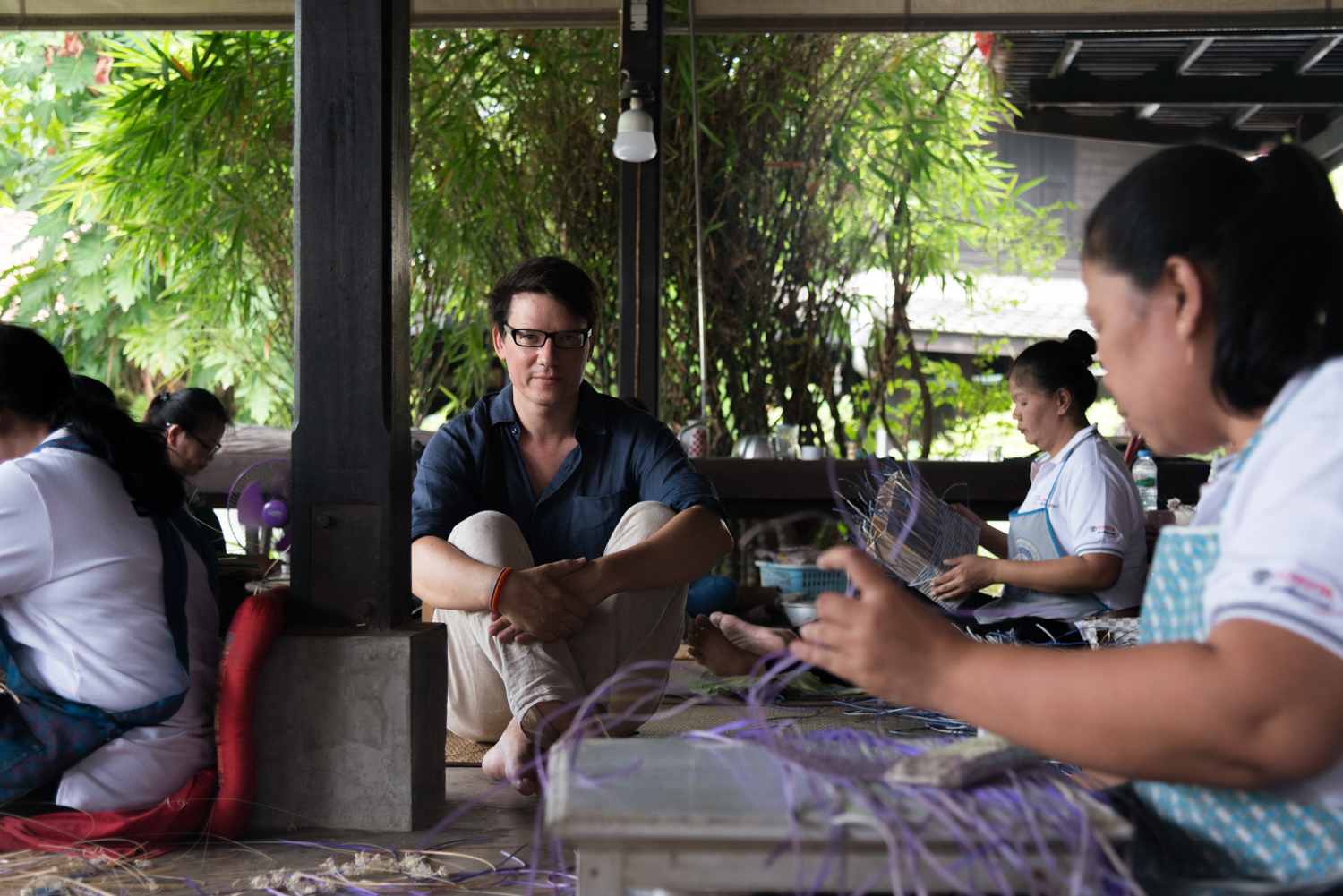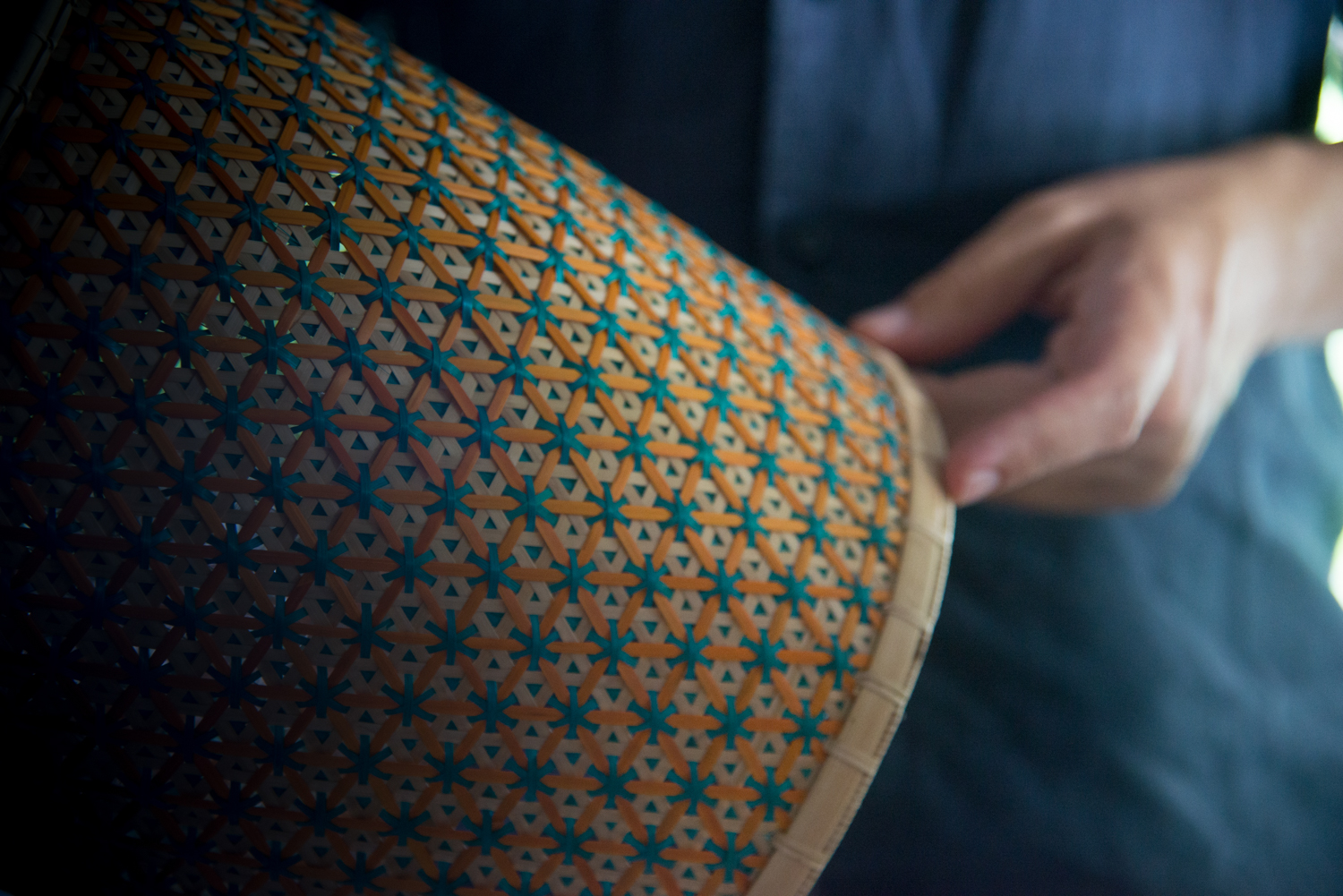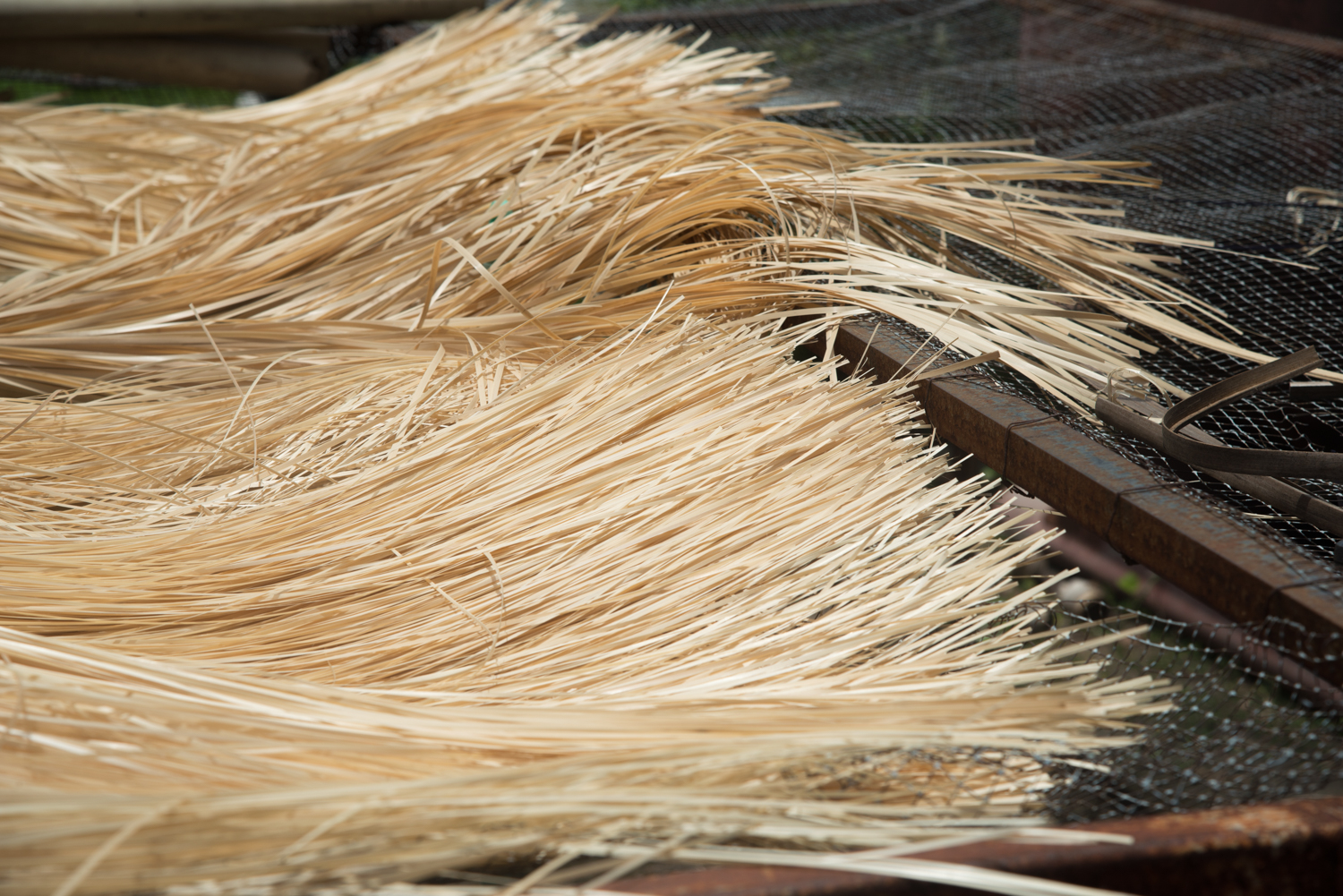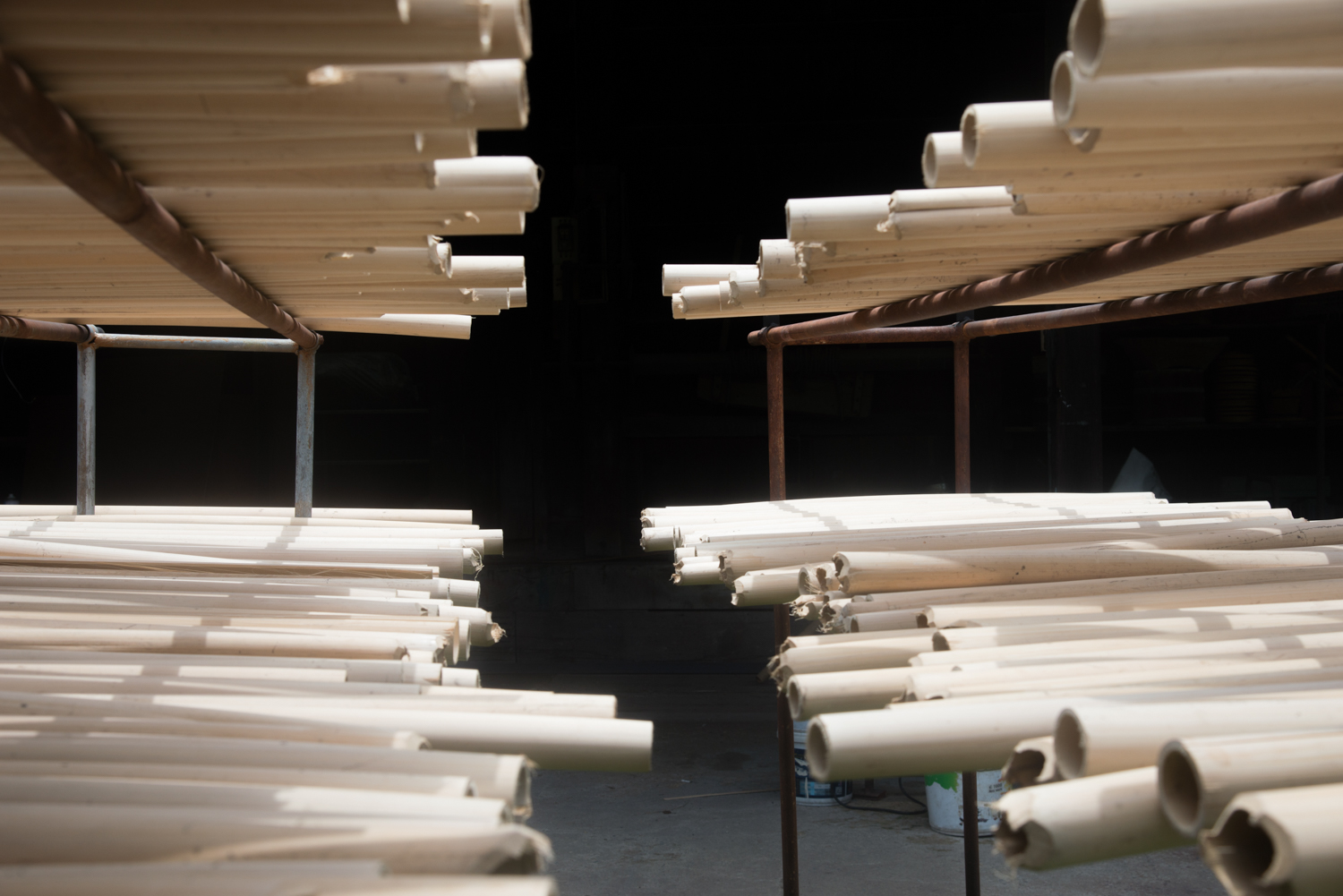After traveling to 5 countries, the PET lamp project comes to Phanat Nikhom through collaboration with Thai artisans

PET Lamp is a collaboration between Alvaro Catalán de Ocón, a Spanish industrial designer, and the Traditional Bamboo Handicraft Center, Phanat Nikhom district, Chonburi. The project was initiated and developed from the idea of using recycled water bottles to create the upper structure of a lamp. The structure was then assembled into the woven bamboo structure with the industrial / handicraft lamp being the final result.
The project was materialized in 2011 when Catalán de Ocón was traveling through the Amazon and witnessed the river polluted with disposed of plastic bottles, which eventually ended up destroying the marine ecosystems. “Not many people are aware of the problem. It’s ironic how short the life cycle of a plastic bottle is, devote the fact that the material can live on for hundreds of years.” Driven not only by the environmental problem he encountered, Catalán de Ocón also told art4d that plastic bottles and bamboo actually share a number of physical qualities. They are massive in number and contain a cylindrical shape with a surface that can be peeled and cut into strips and used for weaving. The screw-on detail at the opening of a plastic bottle works perfectly as a connecting point for the lamp’s power system. PET Lamp also contains a more elaborated meaning as Catalán de Ocón explained that, as an industrial product, these plastic bottles have been manufactured and distributed worldwide, and each bottle contains a tracking number, which allows us to precisely track down the place and date of its origin. “There are superimposed layers of understanding on a plastic bottle, particularly the union of each bottle’s identity (traced by the tracking number) and the varying identities reflected in the patterns created by weaving techniques of different localities and cultures”.
Catalán de Ocón has taken PET Lamp on a journey around the world, from South American countries such as Colombia and Chile, to Ethiopia in Africa and far east lands such as Japan. The lamp created in each area possesses its own distinctive design and none of them are alike. The process usually begins with research to find a potential area where the work can be developed, followed by the team conducting a workshop with a local community to develop a prototype project. Catalán de Ocón then offers the local craftsmen the freedom to improvise. Such creative freedom is something he regards as highly important. “These craftsmen definitely know better than us when it comes to weaving and forming patterns.”
.
When asked about what he found interesting about the handicraft products of Thailand, Catalán de Ocón made some interesting observations. “Apart from the Pikul pattern, the most interesting thing about working here is to be able to see the way people collaborate. They assign different jobs to different people, they have someone responsible for the frame, and another team overseeing the pattern weaving, including the person who does the final touch-up. So it’s very important for each person to take the best responsibility for the work he or she is assigned to do because a mistake at a certain point of the process could have chain reaction effects on the rest.” He defined such as a relationship based method, which caused the lamp to be jam-packed with everyone’s participation. In other words, the lamp is no longer an individual object, but a result of a collaborative process where everybody shares the same goal, which is to create the best work possible.
Defining the lamp as a community object may sound a bit romantic, but it actually brings about so many positive aspects, one being that it allows for PET Lamp Pikul Collection to be released in an actual commercial market. “We had this problem in Japan where a craftsman was responsible for the making of one lamp from start to finish. But it’s different here.” Perhaps the community-based approach is no different from a conveyor system (the only difference is every step of the making of PET Lamp is carried out 100% by human hands). In addition to the connection between an industrial material (plastic bottles) and the local characteristic brought about by Phanat Nikhom’s handicraft techniques, Catalán de Ocón points out that while Thailand has the Pikul tree, Spain has its own Spanish cherry, which he views as a loose, but long-existing cultural connection between Spain and Thailand. It remains to be seen what the Pikul Collection will be materialized into but we heard the latest news is that the collection is set for official launch at Maison & Objet in Paris in early 2019.


PET Lamp เป็นโปรเจ็คต์ที่เกิดจากการร่วมมือกันระหว่าง Alvaro Catalán de Ocón นักออกแบบอุตสาหกรรมจากสเปน กับศูนย์ส่งเสริมฝีมือจักสานด้วยไม้ไผ่ อำเภอพนัสนิคม จังหวัดชลบุรี โดยมีไอเดียหลักอยู่ที่การนำาขวดพลาสติกใช้แล้วมาใช้ซ้ำเป็นโครงสร้างโคมไฟส่วนบนที่จะถูกร้อยเข้ากับโครงไม้ไผ่งานจักสานจนเกิดออกมาเป็นโคมไฟลูกครึ่งอุตสาหกรรม / พื้นถิ่น
โปรเจ็คต์ที่ว่านี้เริ่มต้นขึ้นตั้งแต่ปี 2011 ในตอนที่ Catalán de Ocón เดินทางไปยังลุ่มแม่น้ำาอเมซอนและเจอเข้ากับปัญหาขยะพลาสติกที่หลุดจากมือเราไหลลงแม่น้ำ และไปทำลายระบบนิเวศทางทะเลในท้ายที่สุด “ตอนนั้นยังไม่ค่อยมีใครเห็นปัญหานี้กันเท่าไร มันย้อนแย้งตรงที่ระยะเวลาการใช้งานขวดพลาสติกมันสั้นมากๆ แต่พอเราใช้เสร็จและทิ้งมันไป คุณรู้ไหมว่ามันยังมีชีวิตต่อไปอีกเป็นร้อยๆ ปี” นอกจากแรงขับเคลื่อนจากปัญหาที่พบ Catalán de Ocón ยังบอกอีกว่าขวดพลาสติกคุณสมบัติไม่ต่างอะไรกับไม้ไผ่ตรงที่มันเป็นของที่มีจำานวนมหาศาล มีรูปทรงกระบอกที่นำามาทำางานจักสานได้เมื่อกรีดผิวขวดออกมาเป็นเส้นๆ และสุดท้ายคือ เกลียวบริเวณฝาขวดที่สามารถนำมาใช้เป็นจุดเชื่อมต่อกับระบบไฟฟ้าได้ลงตัวพอดี ส่วนคุณสมบัติในเชิงความหมายนั้น Catalán de Ocón อธิบายเอาไว้ว่า ด้วยความเป็นวัสดุอุตสาหกรรมที่ถูกผลิตและใช้งานทั่วโลก ขวดน้ำทุกขวดจะมี tracking number สลักบนขวด ซึ่งเราสามารถตามไปถึงต้นกำเนิดได้อย่างแม่นยำ ทั้งสถานที่และ วัน/เดือน/ปี ที่ผลิต “บนขวดพลาสติกนั้นมีความเข้าใจหลายๆ ความหมายซ้อนกันอยู่ โดยเฉพาะการมาเจอกันของ identity ของขวด (ที่สืบได้จาก tracking number) และอัตลักษณ์ของลวดลายที่เกิดจากเทคนิคการจักสานที่แตกต่างกันในแต่ละพื้นที่แต่ละวัฒนธรรม”
Catalán de Ocón พาโปรเจ็คต์ PET Lamp เดินทางไปทั่วโลก ไล่ตั้งแต่ประเทศในทวีปอเมริกาใต้อย่างประเทศโคลอมเบียและชิลี ประเทศเอธิโอเปียในทวีปแอฟริกา ไปจนถึงสุดขอบโลกด้านตะวันออกอย่างประเทศญี่ปุ่น ซึ่งโคมไฟจากแต่ละพื้นที่นั้นไม่เคยมีหน้าตาเหมือนกันเลย ขั้นตอนการทำโปรเจ็คต์จะเริ่มจากการรีเสิร์ชพื้นที่ที่มีความเป็นไปได้ ก่อนที่ทีมงานจะลงพื้นที่ไปทำาเวิร์คช็อปกับชุมชนนั้นๆ เพื่อพัฒนาผลิตภัณฑ์ต้นแบบขึ้นมา โดยหลังจากนั้นเขาจะปล่อยให้ช่างฝีมือมีอิสระในการ improvise ซึ่งเขามองว่าการไม่เข้าไปแทรกแซงการทำงานเป็นเรื่องสำคัญมาก “เพราะว่าช่างฝีมือเหล่านั้นรู้ดีกว่าเราแน่ๆ ในเรื่องการผูกลวดลาย”
เมื่อถามถึงความน่าสนใจของเทคนิคการจักสานของที่นี่ Catalán de Ocón ตอบกลับมาว่า “นอกจากลายพิกุล สิ่งที่น่าสนใจที่สุดคือกระบวนการทำางาน ที่นี่แบ่งงานกันทำเป็นระบบว่าใครรับผิดชอบงานขึ้นโครง ใครเป็นคนถักลวดลาย ใครเป็นคนจบงาน ดังนั้นมันจึงจำเป็นมากๆ ที่แต่ละคนจะต้องรับผิดชอบงานในส่วนของตัวเองให้ดีที่สุด เพราะถ้าเกิดว่ามีส่วนไหนทำไม่ดีมันจะส่งผลกระทบต่อส่วนอื่นๆ ตามไปด้วย” เขานิยามการทำงานแบบนี้ว่าเป็น relationship based ที่ทำให้โคมไฟหนึ่งชิ้นนั้นอัดแน่นไปด้วย “การมีส่วนร่วม” ของทุกๆ คน หรือพูดอีกทำนองหนึ่งก็คือมันไม่ได้เป็น individual object โคมไฟของใครของมัน แต่เป็นผลลัพธ์จากการร่วมแรงร่วมใจของช่างฝีมือทุกคนที่มีเป้าหมายเดียวกันนั่นคือ การทำงานออกมาให้ดีที่สุด
นิยามว่า community object อาจจะฟังดูโรแมนติค แต่จริงๆ แล้วมันมีผลดีตามมามากกว่านั้นเพราะมันสามารถทำ ให้ PET Lamp Pikul Collection ออกสู่ตลาด commercial ได้ด้วย “เราเจอปัญหาที่ญี่ปุ่นที่ช่างฝีมือคนหนึ่งจะรับผิดชอบโคมไฟหนึ่งชิ้นไปเลยตั้งแต่ต้นจนจบแต่ที่นี่ไม่ใช่” อันที่จริงการทำงานแบบ community based คงไม่ต่างอะไรกับระบบสายพาน (ถ้าจะต่างก็คือมันเป็นสายพานแบบคราฟต์ที่ทุกกระบวนการใช้มือทำทั้งสิ้น) นอกจากความเชื่อมโยงระหว่างวัสดุอุตสาหกรรม (ขวดพลาสติก) กับความพื้นถิ่นนั่นคือเทคนิคการจักสานของพนัสนิคม Catalán de Ocón บอกกับ art4d ว่าที่สเปนก็มีต้นพิกุลเช่นเดียวกัน (Spanish cherry) และเขามองว่ามันเป็นความสัมพันธ์ทางวัฒนธรรมหลวมๆ ของสเปนและไทยที่มีมาอย่างยาวนาน ต้องอดใจรอกันดูว่าหน้าตาของ Pikul Collection จะออกมาเป็นอย่างไร ได้ข่าวมาว่า Pikul Collection อาจจะเปิดตัวอย่างเป็นทางการในงาน Maison & Objet ที่ปารีสช่วงต้นปีหน้า (2019)
Read the full article on art4d No.262 | Click Here
TEXT & PHOTO: NAPAT CHARITBUTRA
petlamp.org



